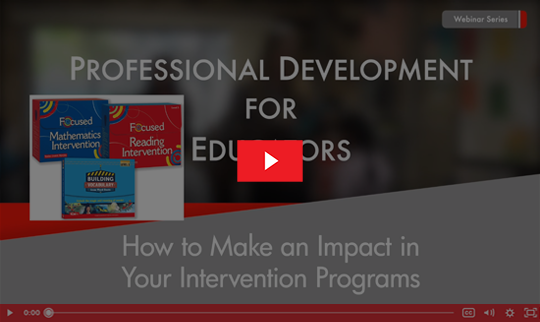5 Qualities of Effective Instructional Intervention
Intervention for students should meet each individual’s learning needs by addressing levels of readiness, learning styles, and interests. The intervention must also address the depth and complexity of state standards. This article will identify key qualities for evaluating any intervention curriculum.
Intervention Must-Haves
W.B. Yeats said, “Education is not the filling of a bucket, but the lighting of a fire.” I think intervention is an excellent way to "light a fire" in my students. It is critical that intervention motivates students, not only for the enjoyment of learning, but to engage students in higher-order thinking, given the rigorous standards and high academic expectations that are required in classrooms.
Intervention programs are commonly used in schools and districts across the United States. These programs are designed to identify and close the achievement gaps in learning and achievement from grade level to grade level.
When you think of intervention, you may picture paper-and-pencil, skill-and-drill activities with rote memorization. Intervention can and should be so much more dynamic. Ideally, intervention will be differentiated, incorporating the student’s readiness, learning styles, and interests. In addition, state standards should be included in the intervention design. Effective intervention curriculum will address the depth and complexities of these standards, while providing differentiation guidance as well.

Here are some qualities that you should look for when evaluating any intervention curriculum.
Incorporate the 3D’s: Diagnose, Decide, and Deliver
An effective intervention curriculum identifies students’ needs and the standards to master, and then provides instruction based on those findings. This process can be done in three easy steps: diagnose, decide, and deliver.
First, administer a pre-test or diagnostic assessment that provides a snapshot of students’ levels of mastery on key learning targets or standards. Then, utilize an assessment item analysis to determine which learning targets and standards must be taught. Finally, deliver engaging lessons to meet those needs.
Develop Language and Vocabulary
Language and vocabulary development are essential components of an intervention program. By frontloading the language and vocabulary used in a lesson, the instruction becomes more comprehensible for students. Academic language must be explicitly taught so students have the words and sentence structures to express their thoughts and ideas.
Differentiate to Meet Students’ Needs
Utilizing the 3D’s (diagnose, decide, deliver) will help determine which standards and lessons can be appropriately used. However, once the standard or lesson has been decided, the students will have varying needs that they bring to the lesson. There will also be varying levels of mastery within an intervention program. To deliver effective instruction, differentiation is necessary. Lessons within intervention should provide multiple instructional strategies, a variety of scaffolding methods, pauses for processing information, and frequent checks to ensure the student understands instructions and concepts.
Integrate Games and Enrichment Activities
Imagine if learning activities, especially intervention activities, felt like summer camp, an after-school club, or a fun recreational activity. Students would be motivated to attend, to be engaged, and to learn. When learning feels less like a struggle or work and more like a meaningful or engaging activity, students are engaged and empowered. Struggling students often miss out on the “fun” activities in class, but these students are likely the ones who need enrichment and progress in higher-order thinking the most.
Intervention can take the form of enrichment. Students can participate in science labs, asking questions, conducting research, and discovering answers to hypotheses. Students can perform Readers’ Theatre, allowing them to have interaction with language instruction, patterns, and collaboration. Playing games offers students the opportunity to assess informational strategies from a variety of perspectives. Working on academics in a game setting allows students to learn without feeling the tension and pressure of traditional methods. Project-based learning can provide an outlet for personalized research and instruction. Art integration strategies can give students an outlet to combine the arts with an academic subject(s) that allows them to express their learning comprehension in a unique manner tailored to their targeted learning assessments. An effective intervention program should provide a variety of ways to integrate activities into the learning environment.
Benefits of Early Planning
Planning early can provide success in intervention programs. When assessing intervention curriculum, it is important to understand what resources, setting, and limitations will or will not be involved. Planning early can provide maximum success in designing effective interventions. The more you can plan ahead, the more prepared you will be for effective implementation. Here are some questions to keep in mind when planning intervention.
- When and where will my intervention program take place?
- How will I assess which students will need to be involved?
- How will parents be notified that their children qualify for intervention?
- Which teachers will be conducting the intervention program?
- What kind of training will those teachers need and when does that need to occur?
- Will students use a consumable resource, or will my teachers photocopy student materials ahead of time?
- Is there additional transportation that needs to be arranged for students who participate in the intervention program?
Once you’ve evaluated and selected your intervention program, review these six impactful strategies for successful school-wide implementation.
These five instructional intervention criteria and intervention planning questions will help you in evaluating resources for your intervention needs. Review programs, making sure there are appropriate diagnostic aids, language and vocabulary instruction, differentiated resources, games and enrichment activities, and that the program will match your resources. Planning in advance allows time to adjust and adapt the program for specific student needs. Most importantly, be sure that your intervention curriculum motivates students to engage in academic achievement and higher-order thinking. The goal of interventions must be to meet individual learning needs and state standards. These criteria will assist in selecting the best possible programs.
Author Bio:
View All AuthorsKarie Gladis, Educational Consultant
Karie Gladis is an educational consultant and former classroom educator with extensive professional development training experiences with administrators, teachers, and parents across all content areas. Karie is the author and editor of several mathematics and language development resources. She has a Masters Degree in Urban Education with an emphasis in Teaching English as a Second Language and a BS in Elementary Education with a minor in Teaching Spanish.
Join the TCM Blog Community
Subscribe by sharing your email address and we will share new posts, helpful resources and special offers on the issues and topics that matter to you and the children and teens you support.

